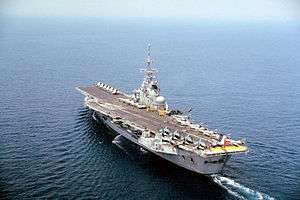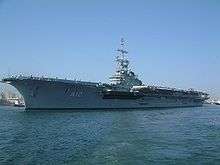French aircraft carrier Foch
Foch (French pronunciation: [fɔʃ]) was the second Clemenceau-class aircraft carrier that served with the French Navy from 1963 to 2000. The carrier was the second warship named in honour of the Marshal of France, British Field Marshal and Marshal of Poland Ferdinand Foch[lower-alpha 1] After serving with the French navy, the vessel was sold to Brazil and renamed São Paulo.
 A port quarter view of Foch (R-99) underway during exercise Dragon Hammer '92. | |
| History | |
|---|---|
| Name: | Foch |
| Namesake: | Ferdinand Foch |
| Ordered: | 1955 |
| Laid down: | 15 November 1957 |
| Launched: | 23 July 1960 |
| Commissioned: | 15 July 1963 |
| Decommissioned: | 15 November 2000 |
| Identification: | R99 |
| Fate: | Sold to the Brazilian Navy, re-named São Paulo. |
| Notes: | See NAe São Paulo for subsequent history |
| General characteristics | |
| Class and type: | Clemenceau-class aircraft carrier |
| Displacement: |
|
| Length: | 265 m (869 ft 5 in) |
| Beam: | 51.2 m (168 ft 0 in) |
| Draught: | 8.6 m (28 ft 3 in) |
| Propulsion: |
|
| Speed: | 32 knots (37 mph; 59 km/h) |
| Range: | 7,500 nmi (13,900 km) at 18 kn (21 mph; 33 km/h) |
| Complement: | 1,338 men, including 64 officers (1,920 men including the air group. 984 men if only helicopters are carried.) |
| Sensors and processing systems: |
|
| Armament: |
|
| Aircraft carried: |
|
Design
The Clemenceau-class aircraft carriers, of which Foch, now renamed and reflagged as São Paulo, is the last surviving member, are of conventional CATOBAR design. The landing area is 165.5 metres (543 ft) long by 29.5 metres (97 ft) wide; it is angled at 8 degrees off of the ship's axis. The flight deck is 265 metres (869 ft) long. The forward aircraft elevator is to starboard, and the rear elevator is positioned on the deck edge to save hangar space. The forward of two 52 metres (171 ft) catapults is at the bow to port, the aft catapult is on the forward area of angled landing deck. The hangar deck dimensions are 152 by 22–24 metres (499 by 72–79 ft) with 7 metres (23 ft) overhead.[2]
History
The draft statute, prepared by the Naval General Staff in 1949, asked for four aircraft carriers of 20,000 tons to be available in two phases. At its meeting of 22 August 1949, the Supreme Council of the Navy was even more ambitious, where they proposed a six aircraft carrier fleet. On 15 July 1952, the French Navy still wanted two to five for the French Navy (not available to NATO). According to RCM 12, the final document of the Lisbon Conference of 1952, France should make available to NATO an aircraft carrier on D-day, two on day 30, three on day 180.
But from 1953, the Navy had to revise its ambitions downwards, with a target of three aircraft carriers.[3]
The PA 54 Clemenceau, budgeted in 1953, was delayed until November 1955, the PA 55 Foch, budgeted for 1955, was delayed until February 1957. Between 1980 and 1981, she underwent a study to certify the platform before catapulting aircraft, carrying missiles, bombs, AM-39 Exocet and tactical nuclear bombs. Like her sister ship Clemenceau, Foch underwent a modernization and refit, replacing four of her eight 100-millimetre (3.9 in) guns with two Crotale air-defense systems. Unlike Clemenceau, Foch also received in 1997 two Sadral launchers (for 6 Mistral missiles each);[4] those launchers were purchased by France in 1994.[5]
The Dassault Rafale was test flown from Foch (but not Clemenceau) after deck modifications in 1992 and operated from this carrier after further 1995-6 deck modifications.[6]
After a 37-year career in the French Navy, on 15 November 2000, the carrier was sold to the Brazilian Navy, and renamed NAe São Paulo. In the French Navy, she was succeeded by Charles de Gaulle (R 91).
Principal operations
Main naval operations for the époque were conducted by the twin carrier Clemenceau. Foch was engaged in the following:
- 1966: Foch participated, with Alfa Force (French: Force Alfa), to the campaign of French nuclear experimentation in the Pacific.
- 1978 : during the Independence of Djibouti, Foch deployed in the Red Sea in Operation Saphir II.
- 1983 : Foch participated to the support of the French contingent deployed in Lebanon within the cadre of the Operation Olifant missions. The carrier would rotate with Clemenceau providing constant on station air support to French peacekeepers in the Multinational Force in Lebanon FSMB and the United Nations Interim Force in Lebanon UNIFIL.
- 1993 - 1999 : Foch was regularly engaged in Operations Balbuzard, Salamandre and Trident in the Adriatic Sea during the engagement of France in ex-Yugoslavia within the cadre of FORPRONU and the SFOR and KFOR. The carrier ensured the security of French elements deployed on the ground, and conducted aerial raids under the command of the United Nations and NATO.
Combat history
In 1977 F-8 Crusaders from 14.F squadron from Foch participated in the Saphir missions over Djibouti. On 7 May 1977, two Crusaders went separately on patrol against what were supposedly French Air Force (4/11 Jura squadron) F-100 Super Sabres stationed at Djibouti. The leader intercepted two fighters and initiated a dogfight as part of the training exercise, but quickly called his wingman for help as he had actually engaged two Yemeni MiG-21 Fishbeds. The two French fighters switched their master armament to "on" but, ultimately, everyone returned to their bases. This was the only combat interception by French Crusaders.
In October 1984, France sent Foch for Operation Mirmillon off the coast of Libya, in response to tension in the Gulf of Sidra.
She was involved in the Yugoslav Wars between July and August 1993, in February and March 1994, and in February and from May to July 1994 in support of UN operations. She also was part of NATO's Allied Force operations with Super Étendards flying strike missions over Serbia in 1999. She was forced to withdraw early four months into her deployment, the longest in her service history, due to problems with her catapult system and other issues.[7]
In 2000, Foch made her last deployment by leading Task Force 473 on a four-month around-the-world tour.[8]
In fiction
Foch was featured prominently in the 1995 film Crimson Tide as the setting for several television news reports about the ongoing conflict in Russia. Foch was used in this role after the U.S. Navy refused to assist in the film's production, thus removing the possibility of filming on board a U.S. carrier.[9]
Foch also appears briefly in Tom Clancy's 1986 techno-thriller novel Red Storm Rising forming part of a NATO task force which also includes the aircraft carriers USS Nimitz and USS Saratoga. In an attack by Soviet Tu-22M bombers, Foch is hit by three anti-ship missiles and sunk.[10]
Foch appears as a playable unit in the RTS game Wargame: Red Dragon in the 'Second Korean War' DLC.
Gallery

 Meuse refueling Foch
Meuse refueling Foch São Paulo, ex-Foch
São Paulo, ex-Foch- Super Étendard ready to be launched from Foch during the ship's 1983 deployment to Lebanon
 F-14 Tomcats overfly Foch in 1990 during an exercise.
F-14 Tomcats overfly Foch in 1990 during an exercise.
Notes
- Ferdinand Foch said in 1911, "Airplanes are interesting toys but of no military value"[1] although this was only eight years after the first powered human flight.
References
- ThinkExist.com Quotations. "Marshal Ferdinand Foch quotes". Thinkexist.com. Archived from the original on 2016-01-09. Retrieved 2013-12-04.
- John Pike. "Clemenceau Aircraft Carrier". Globalsecurity.org. Retrieved 2013-12-04.
- Construction of the third aircraft carrier (the PA58 type), envisaged between 1958 and 1960 was permanently abandoned in 1960 with the release of the five years Loi-Programme (1960-1965) on 6 December 1960.
- www.alabordache.fr (2000-11-15). "Porte-avions Foch". Alabordache.fr. Retrieved 20 July 2015.
- Friedman, Norman (2006). The Naval Institute Guide to World Naval Weapon Systems (5 ed.). Naval Institute Press. p. 575. ISBN 1557502625. Retrieved 20 July 2015.
- Bishop, Chris; Chant, Chris (2004). Aircraft Carriers. Leicester: Zenith Press. pp. 82–3. ISBN 0760320055.
- "Foch Adriatic problems cast long shadow". Sea Power. 1 August 1999. Archived from the original on 24 September 2015. Retrieved 14 August 2015 – via HighBeam Research.
- "British Task Force to Gulf; last voyage for the Foch". Sea Power. 1 April 2000. Archived from the original on 24 September 2015. Retrieved 15 August 2015 – via HighBeam Research.
- Suid, Lawrence (2002). Guts & Glory: The Making of the American Military Image in Film (2 ed.). University Press of Kentucky. p. 748. ISBN 978-0-8131-9018-1.
- Clancy, Tom (1987). Red Storm Rising. Penguin Books. p. 254. ISBN 9781101002346.
Foch took three hits, looks like she's gone
Bibliography
- Warship International Staff (1986). "Question 27/84". Warship International. XXIII (3): 318. ISSN 0043-0374.
Sources
- Boniface, Patrick (September 2015), "Clemenceau carriers", Ships Monthly: 46–49
External links
| Wikimedia Commons has media related to Foch (R99). |
- CV Foch Aircraft Carrier Foch on Alabordache (in French)